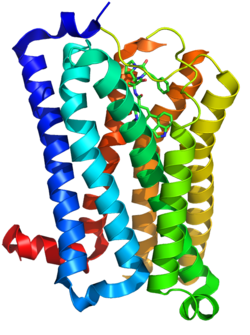Top Qs
Timeline
Chat
Perspective
5-HT1B receptor
Mammalian protein found in Homo sapiens From Wikipedia, the free encyclopedia
Remove ads
5-hydroxytryptamine receptor 1B also known as the 5-HT1B receptor is a protein that in humans is encoded by the HTR1B gene.[5][6] The 5-HT1B receptor is a 5-HT receptor subtype.[7]
Remove ads
Tissue distribution and function
Summarize
Perspective
5-HT1B receptors are widely distributed throughout the central nervous system with the highest concentrations found in the frontal cortex, basal ganglia, striatum, and the hippocampus.[8] The function of the 5-HT1B receptor differs depending upon its location. In the frontal cortex, it is believed to act as a terminal receptor inhibiting the release of dopamine. In the basal ganglia and the striatum, evidence suggests 5-HT signaling acts on an autoreceptor, inhibiting the release of serotonin[9] and decreasing glutamatergic transmission by reducing miniature excitatory postsynaptic potential (mEPSP) frequency,[10] respectively. In the hippocampus, a recent study has demonstrated that activation of postsynaptic 5-HT1B heteroreceptors produces a facilitation in excitatory synaptic transmission which is altered in depression.[11] When the expression of 5-HT1B in human cortex was traced throughout life, significant changes during adolescence were observed, in a way that is strongly correlated with the expression of 5-HT1E.[12]
Outside of the CNS, the 5-HT1B receptor is also expressed on the endothelium of blood vessels, particularly in the meninges.[13] Activation of these receptors results in vasoconstriction. The high distribution of vasoconstrictive 5-HT1B and 5-HT1D receptors around the brain makes them a valuable drug target for the treatment of migraines.[13]
Blocking 5-HT1B receptor signalling also increases the number of osteoblasts, bone mass, and the bone formation rate.[14]
Knockout mice lacking the 5-HT1B gene have been reported to have a higher preference for alcohol, although later studies failed to replicate such abnormalities in alcohol consumption.[15] These mice have also been reported to have a lower measure of anxiety (such as on the elevated plus maze test) and a higher measure of aggression.[15]
Under basal conditions, knockout mice present with a "normal" phenotype and exhibit a sucrose preference (lack of sucrose preference is considered a measure of anhedonia). However, after undergoing chronic unpredictable stress treatment to induce a "depression-like" phenotype these animals do not benefit from administration of selective serotonin reuptake inhibitor (SSRIs).[11][failed verification]
Activation of the serotonin 5-HT1B receptor appears to mediate the prosocial effects of entactogens acting as serotonin releasing agents like MDMA in animals.[16][17][18][19] In addition, serotonin 5-HT1B receptor activation appears to mediate the locomotor hyperactivity of these agents.[20][21][22] The serotonin 5-HT1B receptor also appears to be required for the persisting antidepressant- and anxiolytic-like effects as well as acute hypolocomotion of the serotonergic psychedelic and non-selective serotonin receptor agonist psilocybin in animals.[23]
Remove ads
Ligands
Agonists
- 2ZEDMA (also a 5-HT2A agonist)
- 5-Carboxamidotryptamine (5-CT)
- 5-MAPB[24]
- 5-MAPBT[25]
- 6-MAPB[24]
- 6-MAPBT[25]
- Almotriptan
- Anpirtoline (D-16949)
- Avitriptan
- Batoprazine
- BK-5-MAPB[24]
- BK-5-MAPBT[25]
- BK-6-MAPB[24]
- CGS-12066A
- CP-93,129 (peripherally acting)
- CP-94,253
- CP-122,288 (mixed 5-HT1B/1D agonist)
- CP-135,807 (mixed 5-HT1B/1D agonist)
- Dihydroergotamine
- Donitriptan
- Eletriptan
- Eltoprazine (DU-28853)
- Emodin-8-glucoside
- Ergotamine
- Fluprazine
- Frovatriptan
- L-741604
- Lisuride
- mCPP
- MDMA[26]
- Methylergometrine (methylergonovine)
- Methylone[26]
- Methysergide
- Naratriptan
- Oxymetazoline
- Pergolide
- PZKKN-94 (also a 5-HT6 antagonist)[27]
- Rizatriptan
- RU-24969 (mixed 5-HT1A/1B agonist)
- (S)-DCPT
- Serotonin
- Sumatriptan
- TFMPP
- Tryptamine psychedelics (e.g., 5-MeO-DMT, DPT, psilocin/psilocybin)
- Zolmitriptan
Partial agonists
Antagonists and inverse agonists
- Alprenolol
- AOP-208 (LB-208)
- AR-A000002 (AZD-8129)[28]
- Aripiprazole
- AZD-1134
- AZD-3783
- AZ12320927
- Carteolol
- Elzasonan
- GR-55562
- GR-127935
- Isamoltane (CGP-361A)
- LY-393558
- Metitepine (methiothepin)
- NAS-181 (MCOMM)
- Oxprenolol
- Penbutolol
- Propranolol
- Risperidone
- SB-216,641
- SB-224,289 (inverse agonist)[29]
- SB-236,057 (inverse agonist)[30]
- SB-245,570
- SB-649,915
- Tertatolol
- Yohimbine
Unknown
Remove ads
Genetics
In humans the protein is coded by the gene HTR1B.
A genetic variant in the promoter region, A-161T, has been examined with respect to personality traits and showed no major effect.[32]
See also
References
Further reading
External links
Wikiwand - on
Seamless Wikipedia browsing. On steroids.
Remove ads






